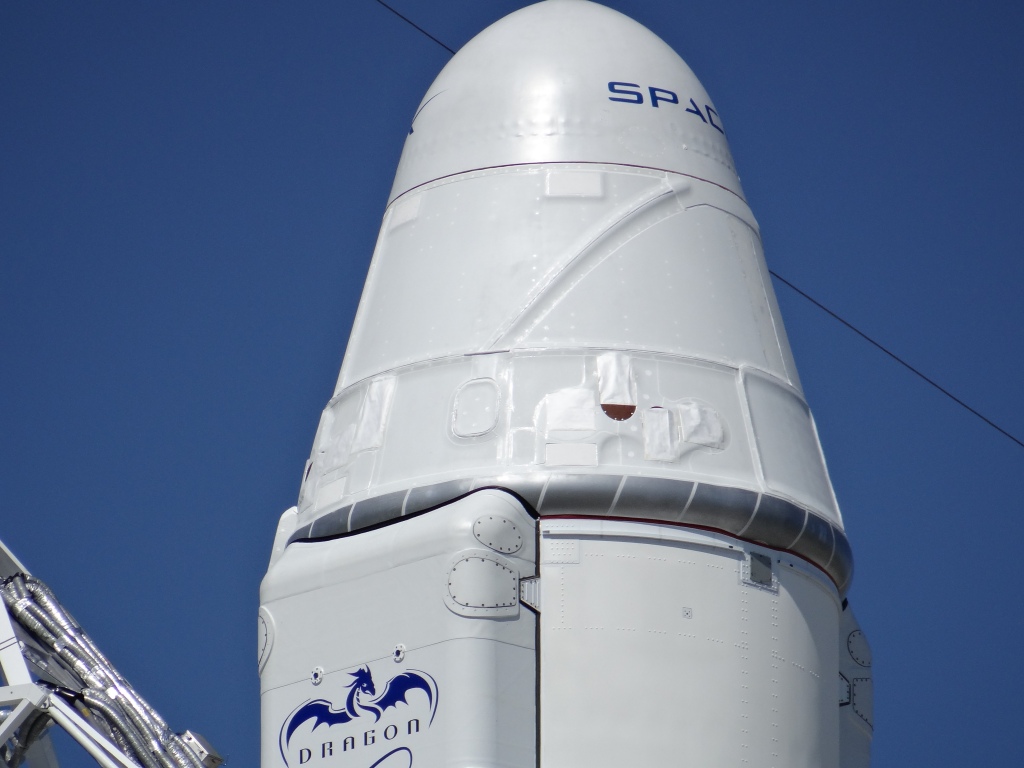Role of Dragon Highlighted in Pre Launch Science Briefing
For most of the International Space Stations’s life until this year, its story has been one of a project under constant construction. As anyone who has undertaken a major construction project while living in the house you are working on at the same time, it is often difficult keep in mind just how good the end product might be.
We may be starting to reach that turning point with ISS. In a science mission briefing prior to Sunday’s historic first supply mission under the Commercial Resupply Contract, scientists from both NASA and CASIS emphasized the fact that with construction of the orbiting outpost complete, the pace and quality of science is measurably accelerating. One of the most critical elements of that progress is the return capacity provided by the Dragon spacecraft. For all the Proton, Soyuz and Progress flights which have gone into building ISS, and Mir before that, the quality of science was always hampered by limitations of a return capability which was restricted essentially to crew. And for sensitive scientific experiments, the Soyuz return profile, which includes a bone jarring rough and tumble landing, is problematic.
Now, Dragon’s overall capacity is allowing NASA to return 384 urine and over 100 frozen blood samples, some of which having been waiting since collection only days after the last Shuttle flight over a year ago. And after years, decades really, of on orbit sample collection, the research is beginning to pay real dividends. For example, Dr. Scott Smith, a nutritionist at Johnson Space Center, displayed a graph showing the relative improvements in bone mineral loss recorded in astronauts aboard ISS, as a result of dietary and exercise changes analyzed in such samples.
The results are sufficiently impressive that it appears for the first time NASA and its partners may be able to fully counteract the deleterious effects of this particular aspect of micro-gravity, with significant implications for Mars mission planning. Achieving this goal will only be possible however, with continued study and subsequent refinement in diet and exercise regimes made possible by the unique return capacity of Dragon.



the CRS-1 will carry only 500 kg of cargo at $133M / 500 = $266,000 per kg! then, where are the “huge payloads” that wait the CRS missions to reach the ISS and that can’t be included in the 50,000 kg of cargo that will be sent to the ISS in 2013 and 2014 with the (already planned) ATV, HTV and Progress missions?
“gm” = Gaetano Marano, the space blog troll.
Gaetano, if you watched the NASA briefing, you would have heard what is going up, and that would have answered your question. In short, they are taking up bulk on this mission, not mass.
And you keep forgetting that NASA has contracted with both SpaceX and Orbital Sciences to supply up to 20,000 kg of cargo each to the ISS. The SpaceX Dragon has plenty of extra mass capability, so NASA doesn’t have to send the average amount each mission, it can adjust the cargo to fit it’s immediate needs – what a concept!
Another thing you would have learned by watching the NASA briefing is the logistics issues of sending cargo to other countries – it takes a long time, so NASA is looking forward to being able to put last-minute cargo onboard the Dragon and Cygnus, which means the CRS logistic system is far more responsive than what the Progress, Shuttle, ATV and HTV have been able to provide.
Despite your ignorant rants, the COTS and CRS programs are doing what NASA needs and wants. Get over it.
“taking up bulk on this mission, not mass”
a $266,000 per kg “bulk”
“can adjust the cargo to fit it’s immediate needs”
so, the real price-per-kg carried will be higher
“put last-minute cargo onboard”
an useless feature for a space station that needs only water & food for six persons
“the COTS and CRS programs are doing what NASA needs and wants”
that is the same that NASA wanted when has paid $10 billion for Constellation: burn money for nothing
for the $10-15 billion that NASA will give a away to the new.space companies in this decade, it will have only 40-50 mt of payload and a dozen of astronauts carried to the ISS
Gaetano (aka “gm”), as usual, you also forget that NASA is using the Dragon for downmass transport too, which in this case is medical samples that could validate experiments done to negate the negative effects of zero-G. If they don’t send the Dragon up, they can’t bring the scientific cargo back.
You assume you know more than NASA, whereas the truth is you don’t.
“for downmass transport too”
that 99% is ISS trash
“medical samples”
small enough to be easily sent back with the Soyuz
only the Shuttle was able to bring back really big things
the ISS has survived perfectly without any “down mass” capability for 30 months after the Columbia accident and for 15 months after the last Shuttle missions, because, this capability is nearly USELESS on a very poorly used space station and with a crew of only six people … surely, not so useful to pay so much money for so little
but this mission is useless also to send the 500 kg up mass … 15 months without a Shuttle mission … and NASA has only 500 kg of payload (about 20% of the payload of a Progress mission!) that must be “urgently” sent to the ISS, also paying a $133M ticket?????
after so much money invested, it was much more rational to wait a few months more, to have a full-3-mt-payload to be sent to the ISS
We may be starting to reach that turning point with ISS.
………….
sad it is, that now it is time to dump the ISS into the Pacific Ocean, such is 21st century planning for the future
Reblogged this on Gigable – Tech Blog.